D Link DWLG710A1 AirPlus GTM 2.4GHz Wireless Range Extender User Manual dwl2000AP 100
D Link Corporation AirPlus GTM 2.4GHz Wireless Range Extender dwl2000AP 100
D Link >
Contents
- 1. Users Manual 1
- 2. Users Manual 2
Users Manual 1

Manual
Building Networks for People
D-Link AirPlusTM G
DWL-G710
802.11g Wireless Range Extender
2
Contents
Package Contents ................................................................................3
Introduction............................................................................................4
Connections..........................................................................................5
LEDs ....................................................................................................6
Features ...............................................................................................7
Wireless Basics ....................................................................................8
Installation Considerations ..................................................................10
Getting Started ....................................................................................11
Using the Configuration Menu..............................................................13
Networking Basics .............................................................................19
Troubleshooting...................................................................................34
Technical Specifications ......................................................................41
Contacting Technical Support ..............................................................44
Warranty..............................................................................................45
Registration ........................................................................................48
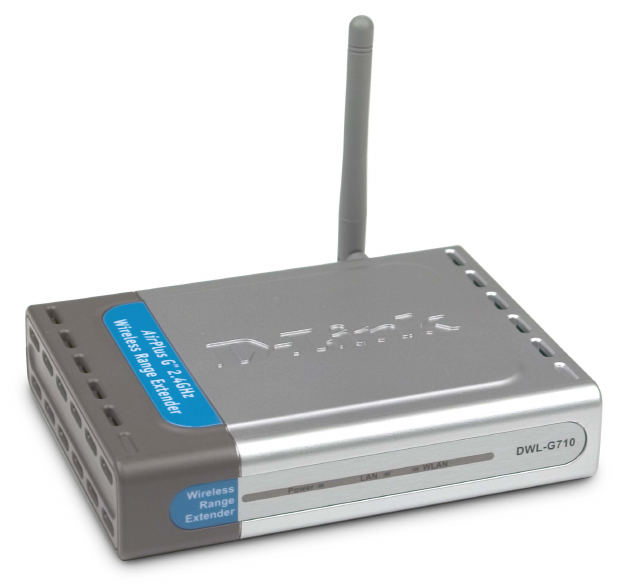
3
Contents of Package:
D-Link AirPlus G DWL-G710
802.11g Wireless Range Extender
Power Adapter-DC 5V, 2.0A
Manual on CD
Quick Installation Guide
Ethernet Cable
TM
Internet Explorer version 6.0 or Netscape Navigator version
7.0 and above
Computers with Windows, Macintosh, or Linux-based
operating systems with an installed Ethernet adapter
Package Contents
Note: Using a power supply with a different voltage rating than the one included with the
DWL-G710 will cause damage and void the warranty for this product.
If any of the above items are missing, please contact your reseller.
System Requirements for Configuration:
4
Introduction
With a maximum wireless signal rate of up to five times the rate of previous wireless
devices (up to 54Mbps*), you can work faster and more efficiently, increasing productivity.
With the DWL-G710, bandwidth-intensive applications like graphics or multimedia will
benefit significantly because large files are able to move across the network quickly.
The D-Link AirPlusTM G DWL-G710 Wireless Range Extender can repeat the wireless
signal of D-Link AirPlusTM G access points and wireless routers to extend the range of
your wireless network.
The DWL-G710 is capable of a maximum wireless signal rate of up to 54Mbps when
used with other D-Link AirPlusTM G products such as the DWL-G510 Wireless PCI
Adapter, DWL-G630 Wireless Cardbus Adapter, and the DI-524 Wireless Router.
The DWL-G710 is compatible with most popular operating systems, including Macintosh,
Linux and Windows, and can be integrated into a large network.
*Maximum wireless signal rate based on IEEE Standard 802.11g specifications. Actual data throughput will
vary. Network conditions and environmental factors lower actual data throughput rate.
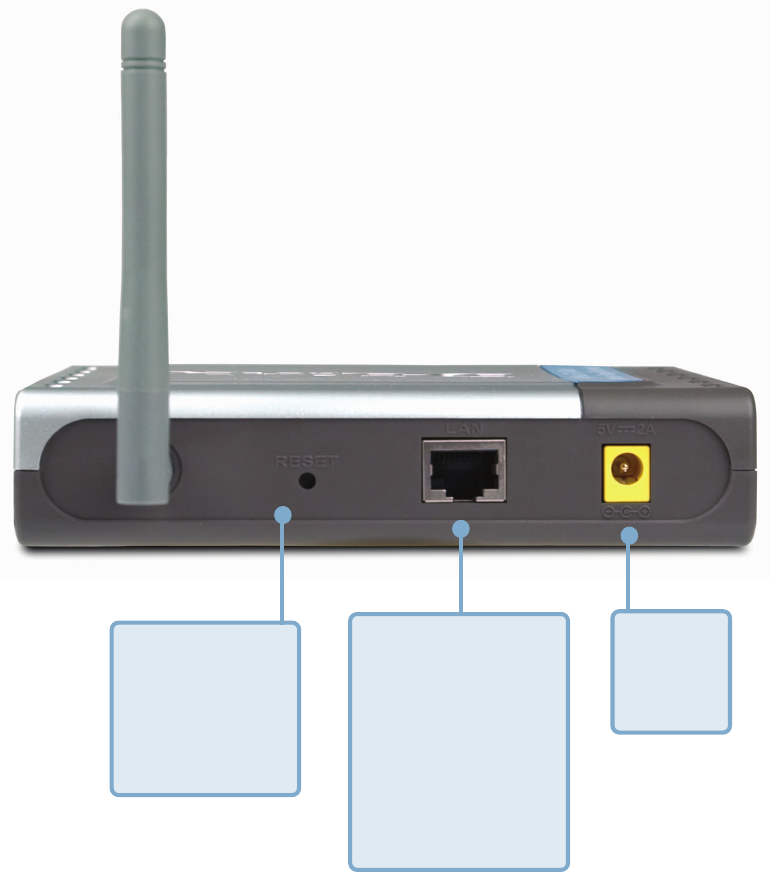
5
Connections
Receptor
for the
Power
Adapter
Pressing the
Reset Button
restores the
DWL-G710 to its
original factory
default settings.
The LAN Port is
Auto-MDI/MDIX. You
can insert either a
straight-through or a
crossover Ethernet
cable in this port in
order to connect the
DWL-G710 to the
local network.
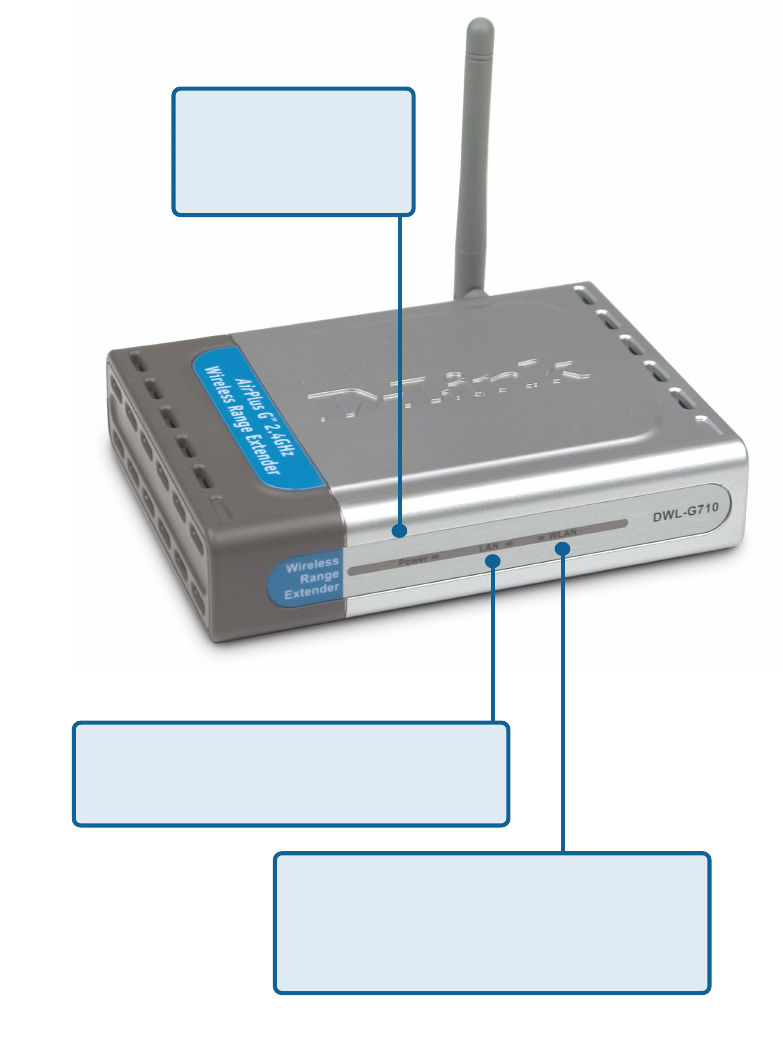
6
LEDs
LED stands for Light-Emitting Diode. The DWL-G710 Wireless Range Extender has 3
LEDs as shown below:
A steady green light indicates a good wireless
connection. A blinking light indicates that the
DWL-G710 is receiving/transmitting from/to
the wireless network.
WLAN:
Power:
A steady green light
indicates a connection to
a power source.
A steady green light indicates a good Ethernet
connection.
LAN:
7
Extends the range of your wireless network.
With a maximum wireless signal rate of up to 54Mbps* with AirPlus G Products,
the DWL-G710 delivers media rich content such as digital images, videos, and
MP3 files much faster than standard 802.11b networks.
Fully 802.11b compatible – Fully compatible with the IEEE 802.11b standard
and interoperable with all existing 802.11b compliant devices.
Easy setup with the setup wizard.
Web-based interface for managing and configuring – Easy-to-use interface
independent of the operating system.
Auto-MDI/MDIX Ethernet port.
Features and Benefits
*Maximum wireless signal rate based on IEEE Standard 802.11g specifications. Actual data throughput
will vary. Network conditions and environmental factors lower actual data throughput rate.
Simple configuration with the Site Survey tool. Just click on a network to
extend the range of an access point or router in that network. No MAC
addresses needed.
8
Wireless Basics
Wireless users can use the same applications they use on a wired network. Wireless
adapter cards used on laptop and desktop systems support the same protocols as
Ethernet adapter cards.
D-Link wireless products are based on industry standards to provide easy-to-use and
compatible high-speed wireless connectivity within your home, business or public access
wireless networks. D-Link wireless products will allow you access to the data you want,
when and where you want it. You will be able to enjoy the freedom that wireless networking
brings.
A wireless local area network (WLAN) is a computer network that transmits and receives
data with radio signals instead of wires. WLANs are used increasingly in both home and
office environments, and public areas such as airports, coffee shops and universities.
Innovative ways to utilize WLAN technology are helping people to work and communicate
more efficiently. Increased mobility and the absence of cabling and other fixed
infrastructure have proven to be beneficial for many users.
People use WLAN technology for many different purposes:
Mobility - Productivity increases when people have access to data in any location
within the operating range of the WLAN. Management decisions based on real-time
information can significantly improve worker efficiency.
Low Implementation Costs - WLANs are easy to set up, manage, change and
relocate. Networks that frequently change can benefit from WLANs ease of
implementation. WLANs can operate in locations where installation of wiring may be
impractical.
Installation and Network Expansion - Installing a WLAN system can be fast and
easy and can eliminate the need to pull cable through walls and ceilings. Wireless
technology allows the network to go where wires cannot go - even outside the home or
office.
Inexpensive Solution - Wireless network devices are as competitively priced as
conventional Ethernet network devices.
Scalability - WLANs can be configured in a variety of ways to meet the needs of
specific applications and installations. Configurations are easily changed and range
from Peer-to-Peer networks suitable for a small number of users to larger Infrastructure
networks to accommodate hundreds or thousands of users, depending on the number
of wireless devices deployed.
9
Wireless Basics (continued)
Standards-Based Technology
The DWL-G710 Wireless Range Extender utilizes the 802.11b and the 802.11g standards.
The IEEE 802.11g standard is an extension of the 802.11b standard. It increases the
maximum wireless signal rate up to 54Mbps* within the 2.4GHz band, utilizing OFDM
technology.
This means that in most environments, within the specified range of this device, you will
be able to transfer large files quickly or even watch a movie in MPEG format over your
network without noticeable delays. This technology works by transmitting high-speed
digital data over a radio wave utilizing OFDM (Orthogonal Frequency Division Multiplexing)
technology. OFDM works by splitting the radio signal into multiple smaller sub-signals
that are then transmitted simultaneously at different frequencies to the receiver. OFDM
reduces the amount of crosstalk (interference) in signal transmissions. The D-Link
DWL-G710 will automatically sense the best possible connection speed to ensure the
greatest speed and range possible.
The DWL-G710 is compatible, in default mode, with the following wireless products:
D-Link AirPlusTM G DWL-G510
Wireless PCI Adapter used with desktop computers
D-Link AirPlusTM G DWL-G630
Wireless Cardbus Adapter used with laptop computers
D-Link AirPlusTM G DI-524
Wireless Router
The DWL-G710 is also interoperable with other 802.11g and 802.11b
standards-compliant devices.
*Maximum wireless signal rate based on IEEE Standard 802.11g specifications. Actual data throughput will
vary. Network conditions and environmental factors lower actual data throughput rate.
10
Wireless Basics (continued)
Installation Considerations
The D-Link AirPlus G DWL-G710 lets you access your network, using a wireless
connection, from virtually anywhere within its operating range. Keep in mind, however,
that the number, thickness and location of walls, ceilings, or other objects that the
wireless signals must pass through, may limit the range. Typical ranges vary depending
on the types of materials and background RF (radio frequency) noise in your home or
business. The key to maximizing wireless range is to follow these basic guidelines:
TM
Keep your product away (at least 3-6 feet or 1-2 meters) from electrical devices
or appliances that generate RF noise.
4
Keep the number of walls and ceilings between the DWL-G710 and other network
devices to a minimum - each wall or ceiling can reduce your DWL-G710’s range
from 3-90 feet (1-30 meters.) Position your devices so that the number of walls
or ceilings is minimized.
1
Be aware of the direct line between network devices. A wall that is 1.5 feet thick
(.5 meters), at a 45-degree angle appears to be almost 3 feet (1 meter) thick. At
a 2-degree angle it looks over 42 feet (14 meters) thick! Position devices so that
the signal will travel straight through a wall or ceiling (instead of at an angle) for
better reception.
2
Building materials can impede the wireless signal - a solid metal door or aluminum
studs may have a negative effect on range. Try to position wireless devices and
computers with wireless adapters so that the signal passes through drywall or
open doorways and not other materials.
3
11
A laptop computer with a wireless adapter -
D-Link AirPlusTM G DWL-G630
A desktop computer with a wireless adapter -
D-Link AirPlusTM G DWL-G510
A cable modem - D-Link DCM-201
Getting Started
On the following pages we will show you an example of an Infrastructure Network
incorporating the DWL-G710.
An Infrastructure network contains an access point or a wireless router. The
Infrastructure Network example shown on the following page contains the following
D-Link network devices (your existing network may be comprised of other devices):
A wireless router - D-Link AirPlusTM G DI-524
A wireless range extender -
D-Link AirPlusTM G DWL-G710
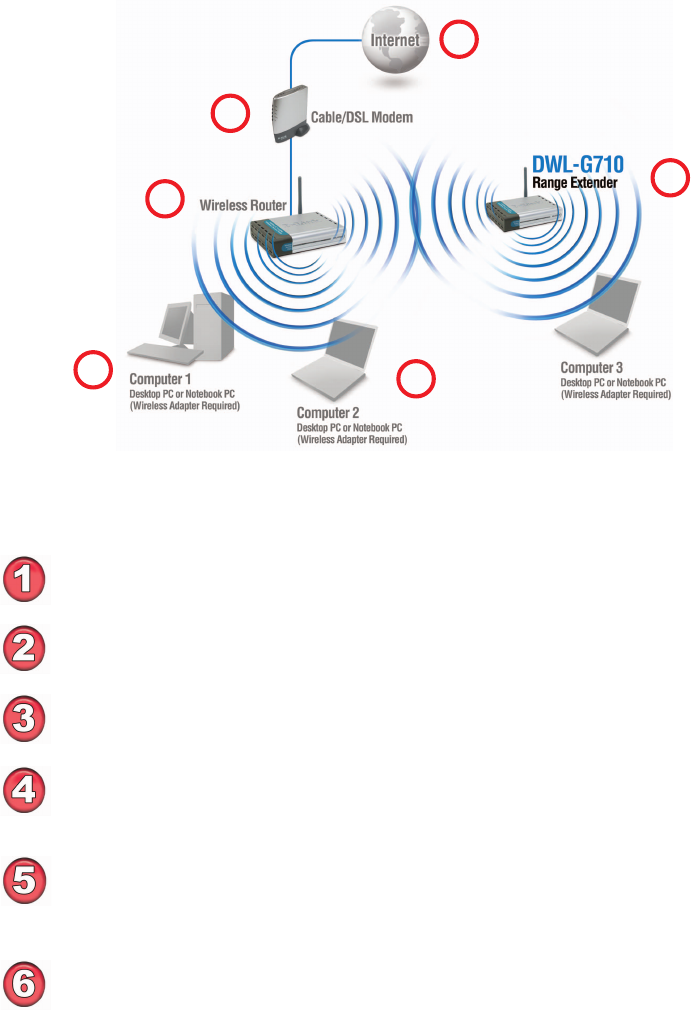
12
You will need broadband Internet access (a cable or DSL-subscriber line into
your home or office).
Consult with your cable or DSL provider for proper installation of the modem.
Connect the cable or DSL modem to the DI-524 router. (See the printed Quick
Installation Guide included with your router.)
If you are connecting a desktop computer to your network, install the D-Link AirPlus
G DWL-G510 wireless PCI adapter into an available PCI slot on your desktop
computer.*
(See the printed Quick Installation Guide included with the network adapter.)
Install the D-Link DWL-G630 wireless cardbus adapter into a laptop computer.
(See the printed Quick Installation Guide included with the DWL-G630.)*
Getting Started (continued)
For a typical wireless setup at home (as shown above), please do the following:
An example of a wireless Infrastructure network
11
11
1
22
22
2
33
33
344
44
4
Configure the DWL-G710 to communicate with the DI-524 router. (See the printed
Quick Installation Guide included with the DWL-G710.)
66
66
6
55
55
5
TM
Please remember that D-Link AirPlus G wireless devices are pre-configured to
connect together, right out of the box, with their default settings.
TM
*Both DWL-G630 and DWL-G510 should be configured to
communicate with the DWL-G710, not the router.
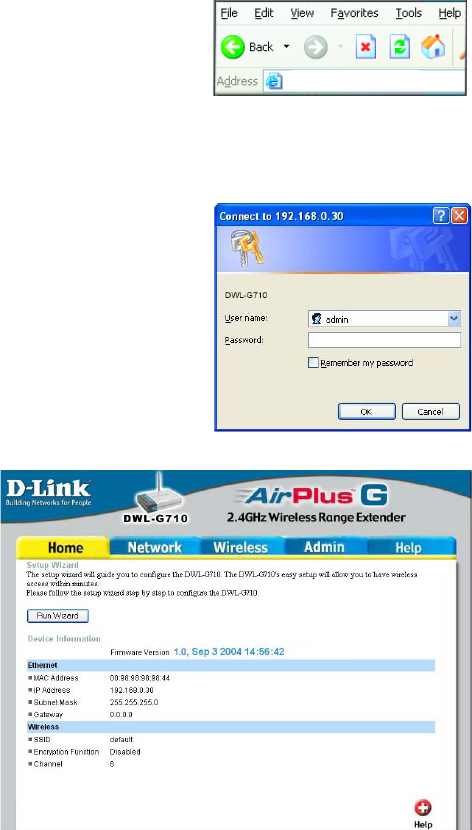
13
Note: if you have changed the default IP address assigned to the DWL-G710, make sure to
enter the correct IP address.
Using the Configuration Menu
Home > Wizard
The Home>Wizard screen will
appear. Please refer to the
Quick Installation Guide for
more information regarding the
Setup Wizard.
After you have completed the Setup Wizard (please see the Quick Installation Guide that
came with the product) you can access the Configuration menu at any time by opening
the Web browser and typing in the IP address of the DWL-G710. The DWL-G710 default
IP address is shown below:
http://192.168.0.30
Type admin in the User name field.
Leave the Password blank.
(However, if you have changed
the password, please enter the
correct password.)
Click OK.
Open the Web browser.
Type in the IP address of the
DWL-G710.
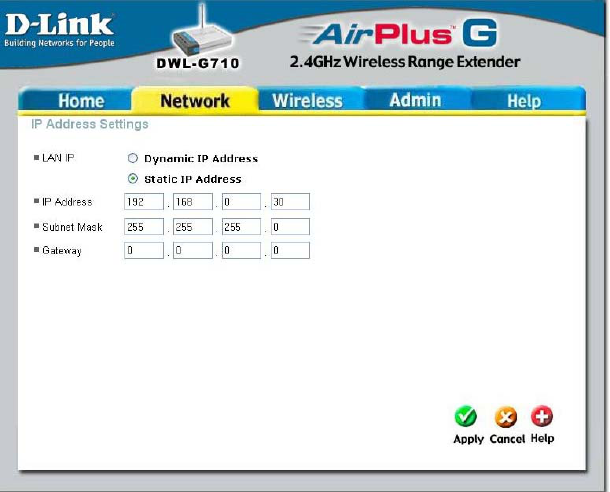
14
Using the Configuration Menu (continued)
Network
Gateway- Enter the IP address of the router in the network.
LAN IP- Select this option to receive a dynamic IP
address from the DHCP server on your network.
IP Address- When Static IP Address is selected, you will input the static IP
address of the DWL-G710 into this field. The IP address must be within
the range of the IP addresses in your network.
Subnet
Mask- Enter the subnet mask.
Apply- Click Apply to save the changes.
Dynamic IP Address-
Static IP Address- Assign a static IP address to the DWL-G710.
This selection is recommended for ease of
network configuration.
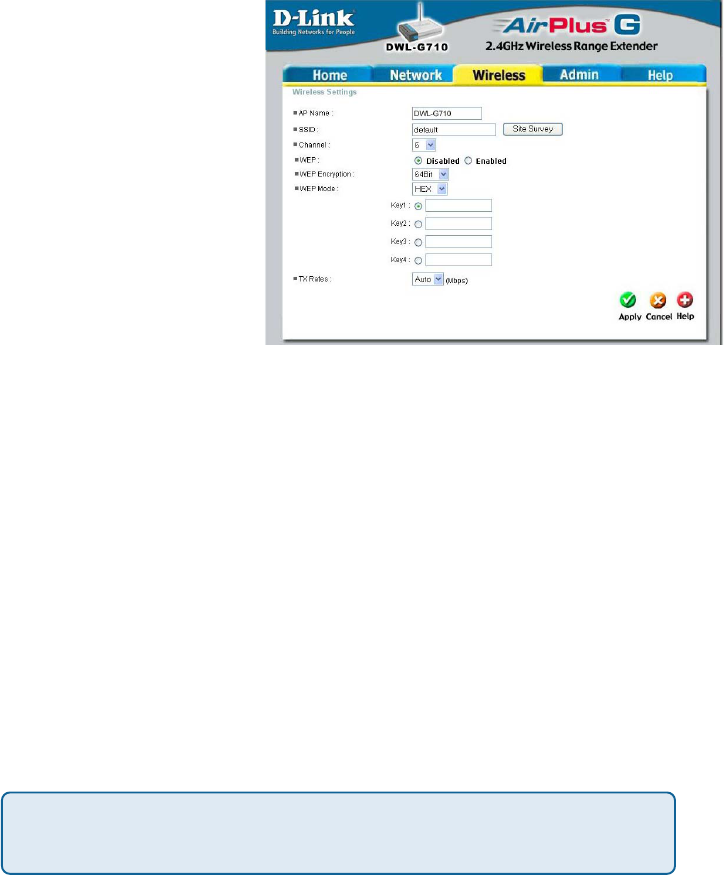
15
WEP - For a level of security, select Enable Encryption to use WEP (Wired Equivalent
Privacy) on the network. All devices on the network, and the access point, must share
the same WEP selection - either Enable or Disable.
Site Survey - Click Site
Survey to receive a list of
networks that are available for
connection. Please see the
screen on the following page for more information on this feature.
SSID (Service Set
Identifier) -
Using the Configuration Menu (continued)
Wireless
AP Name -
You may choose to rename
your DWL-G710, especially if
you have more than one
DWL-G710 on your network.
WEP Encryption - Select either 64- or 128-bit length.
WEP Mode - Select ASCII or Hexadecimal mode and then input the appropriate
digits or letters into each Key field. You can create up to 4 keys. Select the key you
wish to use.
Enter the SSID of the network
you wish to repeat.
TX Rates - Select the transmission rate for the network.
Hexadecimal digits consist of the numbers 0-9 and the letters A-F
ASCII (American Standard Code for Information Interchange) is a code for
representing English letters as numbers from 0-127
Apply - Click Apply to save the changes.
Channel - Select the channel from the pulldown menu.
All devices on the network must share the same channel in order to communicate.
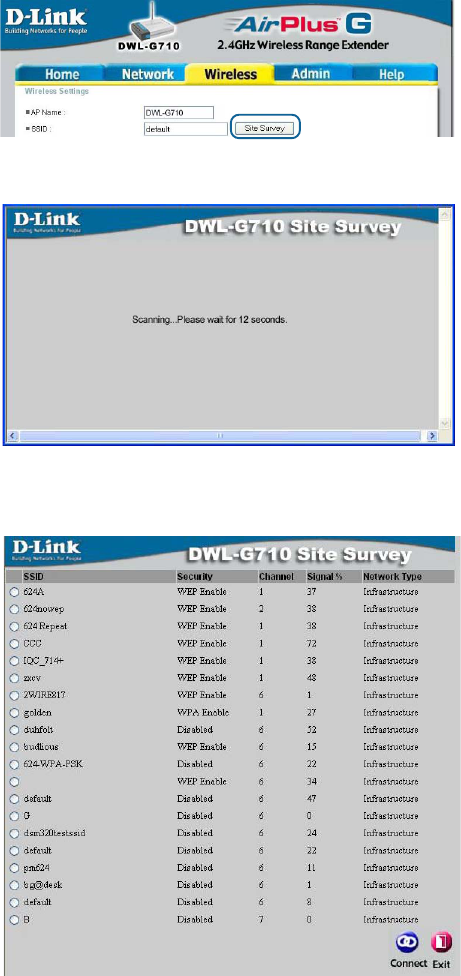
16
Using the Configuration Menu (continued)
Site Survey
Click Site Survey in the
Wireless configuration screen
displayed on the previous page.
The DWL-G710 will scan the
network. Please wait a few
seconds for this process to
complete.
Scanning
Site Survey Completed
The Site Survey displays the
features of each available network
as follows:
SSID- Displays the network
name.
Security- Displays the type of
security being used, or indicates
that security is disabled.
Channel- Indicates the channel
the network is using.
Signal%- Displays the signal
strength of the network.
Network Type- Indicates the net-
work type: Infrastructure or
Ad-Hoc.
The information shown here
allows you to select a network to
join, or gives you the information
you need to configure your
DWL-G710 for connection to a
specific network.
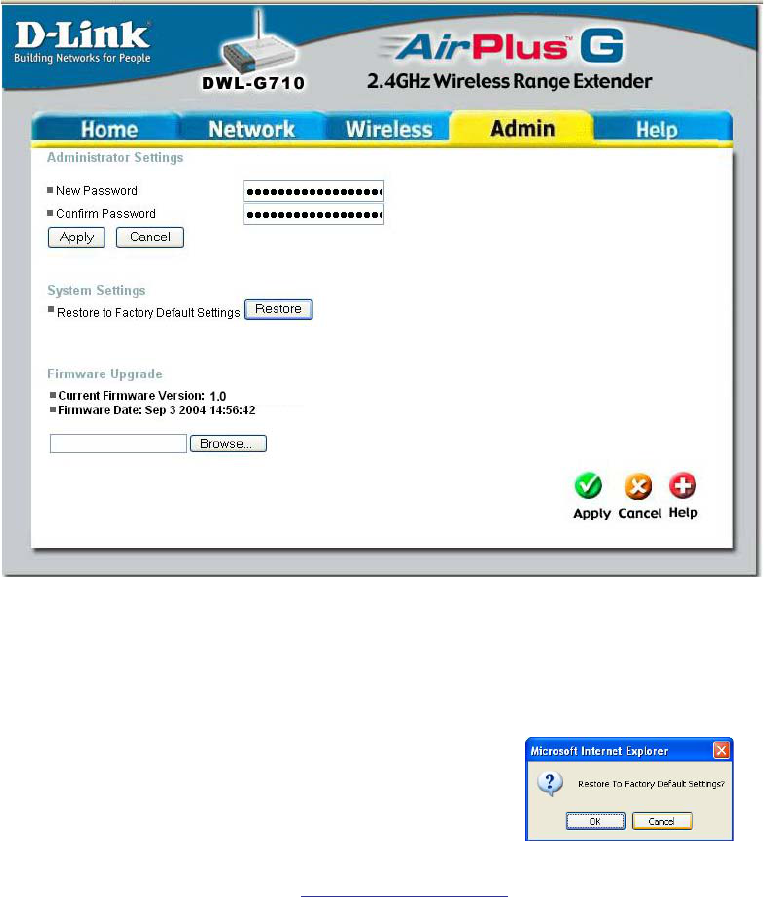
17
Using the Configuration Menu (continued)
Admin
Apply - Click Apply if you have made any changes.
Administrator Settings - Change your password in this window. Re-enter the new
password to confirm. It can be up to 14 characters in length. Please keep a copy of your
password in a safe place.
Click Apply, if you have made any changes. Click Cancel to clear the changes.
Restore to Factory Default Settings - Click Restore to return to Factory Default
Settings. (You will lose the current settings.)
Firmware Upgrade - Upgrade the firmware for the DWL-G710. Find upgrades to the
firmware on the D-Link website at http://support.dlink.com. After you have downloaded
a firmware upgrade to your local drive, click Browse. Select the firmware and click
Apply to complete the upgrade. Do not upgrade firmware from a computer with a
wireless connection. Doing so may damage the device.
When you click Restore, the dialog box at right will appear.
Click OK to restore to factory default settings or click Cancel
to cancel the procedure.
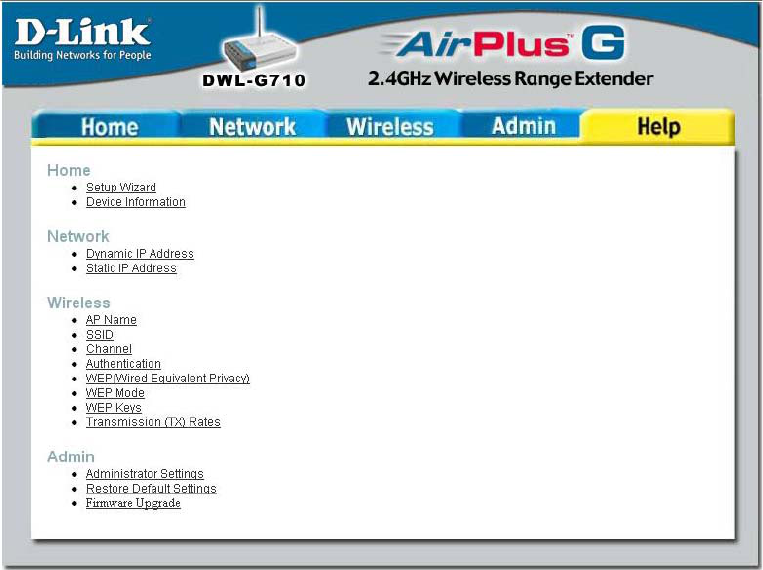
18
Using the Configuration Menu (continued)
Help
Help Menu - Click on any item in the Help menu for more information.
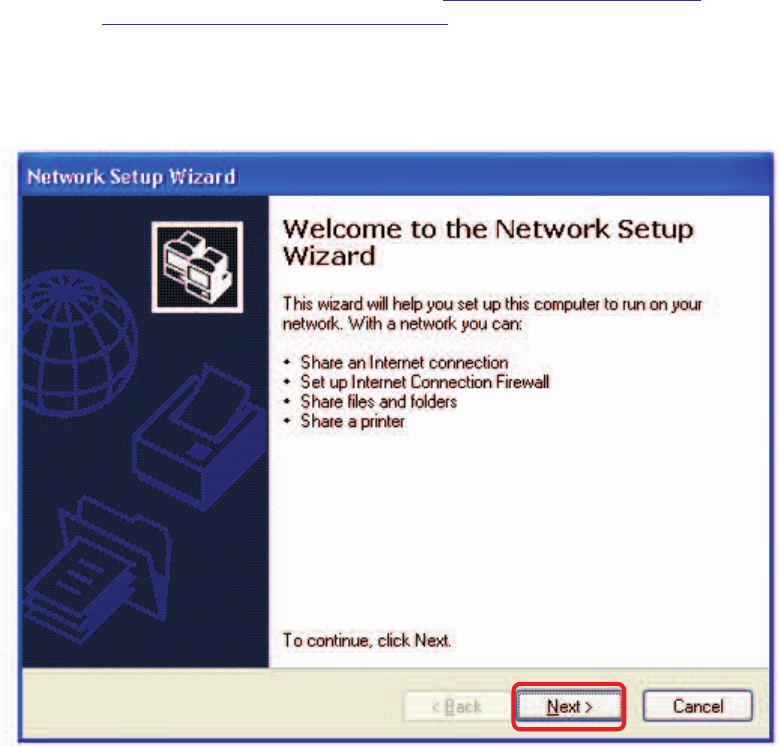
19
Using the Network Setup Wizard in Windows XP
In this section you will learn how to establish a network at home or work, using
Microsoft Windows XP.
Note: Please refer to websites such as http://www.homenethelp.com
and http://www.microsoft.com/windows2000 for information about networking
computers using Windows 2000/Me/98SE.
Go to Start>Control Panel>Network Connections
Select Set up a home or small office network
Networking Basics
When this screen appears, click Next.
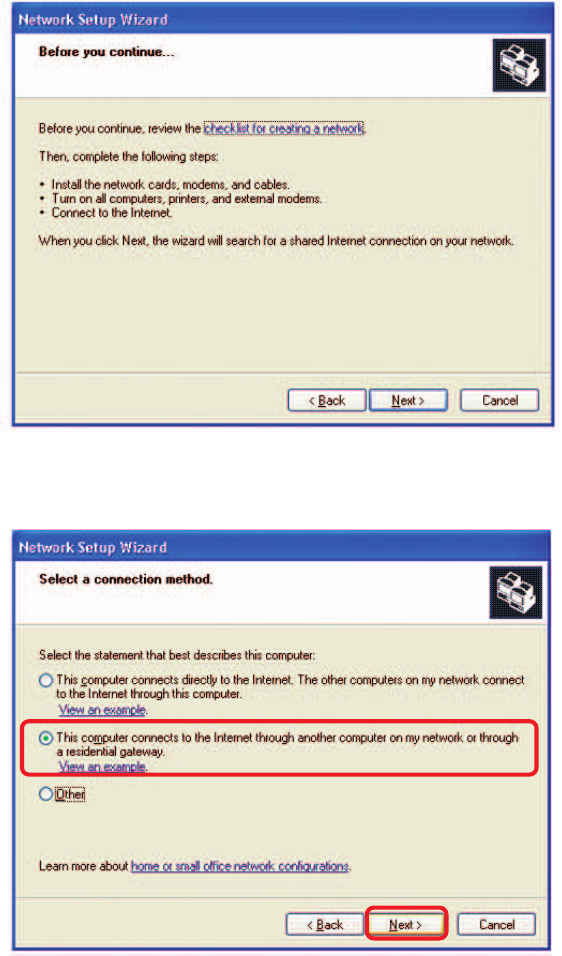
20
Please follow all the instructions in this window:
Networking Basics (continued)
Click Next.
In the following window, select the best description of your computer. If your computer
connects to the Internet through a router, select the second option as shown.
Click Next.
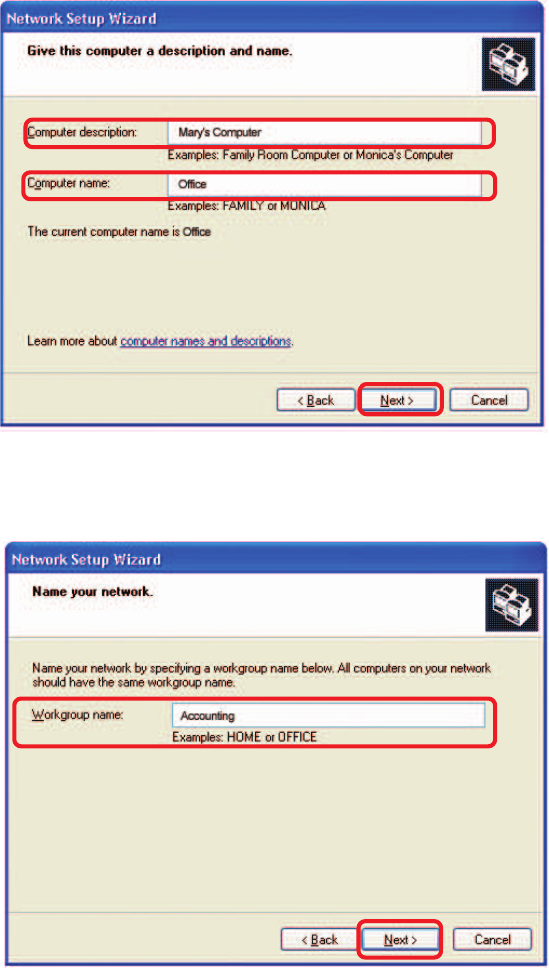
21
Enter a Computer description and a Computer name (optional.)
Networking Basics (continued)
Click Next.
Enter a Workgroup name. All computers on your network should have the same
Workgroup name.
Click Next.
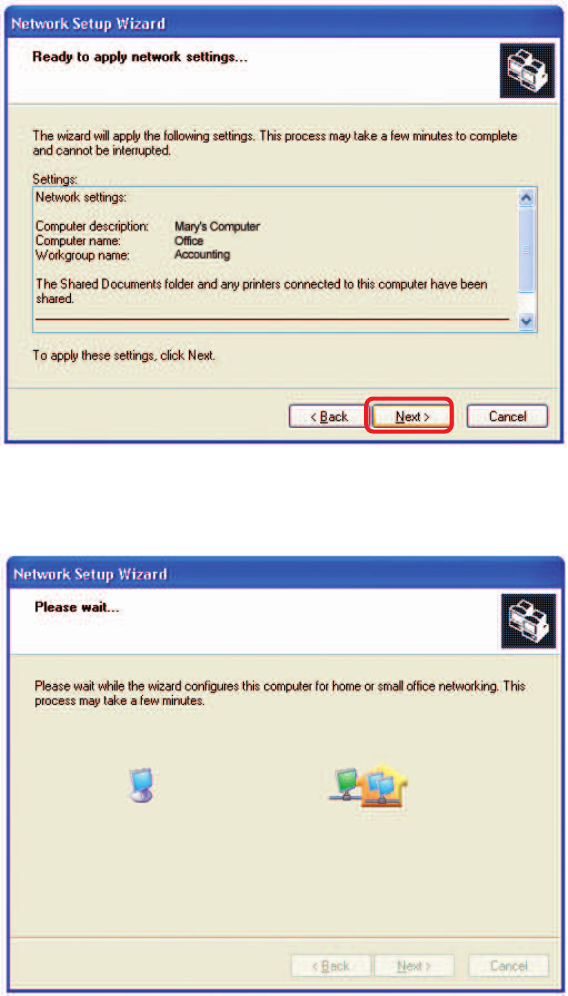
22
Please wait while the Network Setup Wizard applies the changes.
Networking Basics (continued)
When the changes are complete, click Next.
Please wait while the Network Setup Wizard configures the computer.
This may take a few minutes.
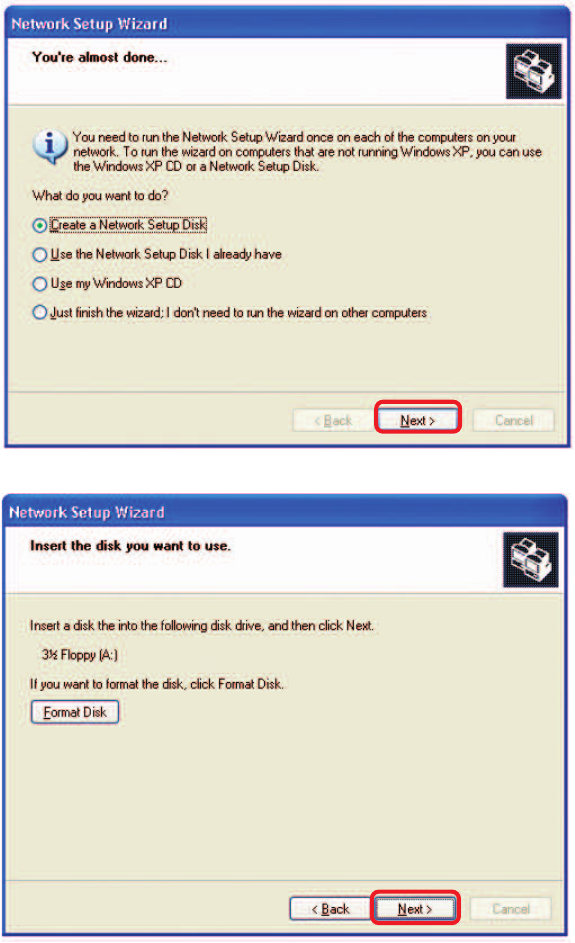
23
Networking Basics (continued)
Click Next.
Insert a disk into the Floppy Disk Drive, in this case drive A.
In the window below, select the option that fits your needs. In this example, Create a
Network Setup Disk has been selected. You will run this disk on each of the
computers on your network. Click Next.
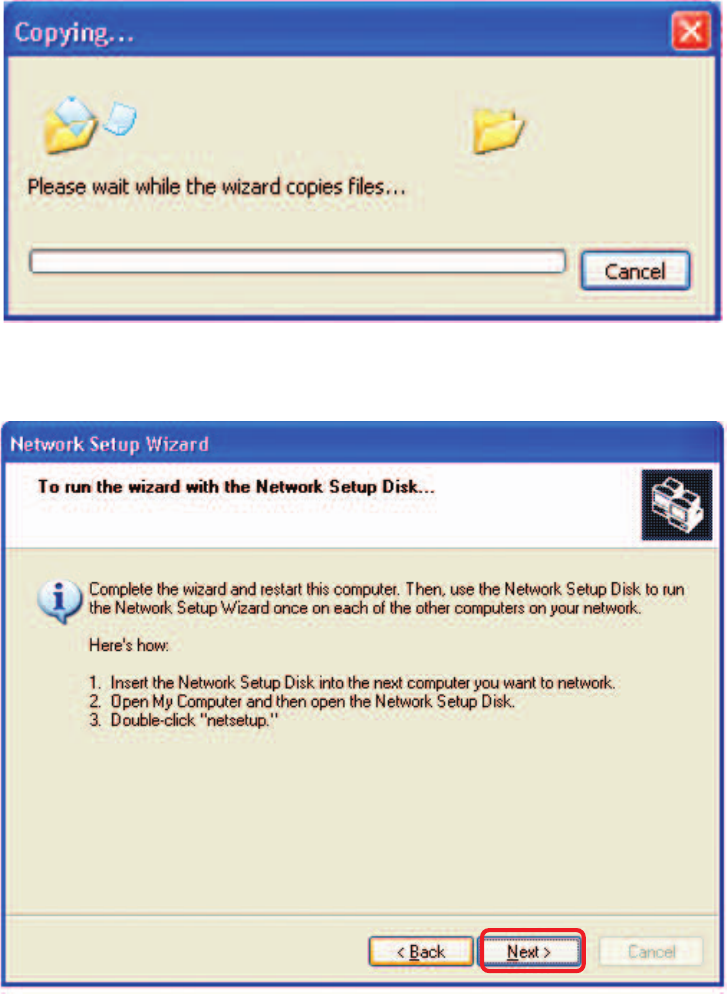
24
Networking Basics (continued)
Please read the information under Here’s how in the screen below. After you complete
the Network Setup Wizard you will use the Network Setup Disk to run the Network
Setup Wizard once on each of the computers on your network. Click Next.
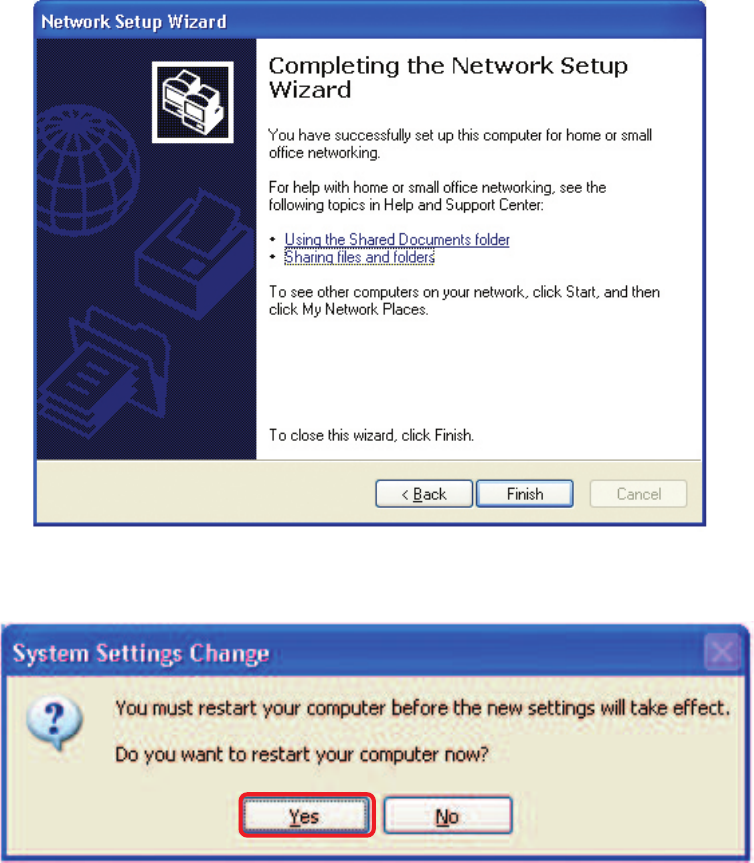
25
Networking Basics (continued)
The new settings will take effect when you restart the computer. Click Yes to restart
the computer.
You have completed configuring this computer. Next, you will need to run the Network
Setup Disk on all the other computers on your network. After running the Network
Setup Disk on all your computers, your new wireless network will be ready to use.
Please read the information on this screen, then click Finish to complete the
Network Setup Wizard.
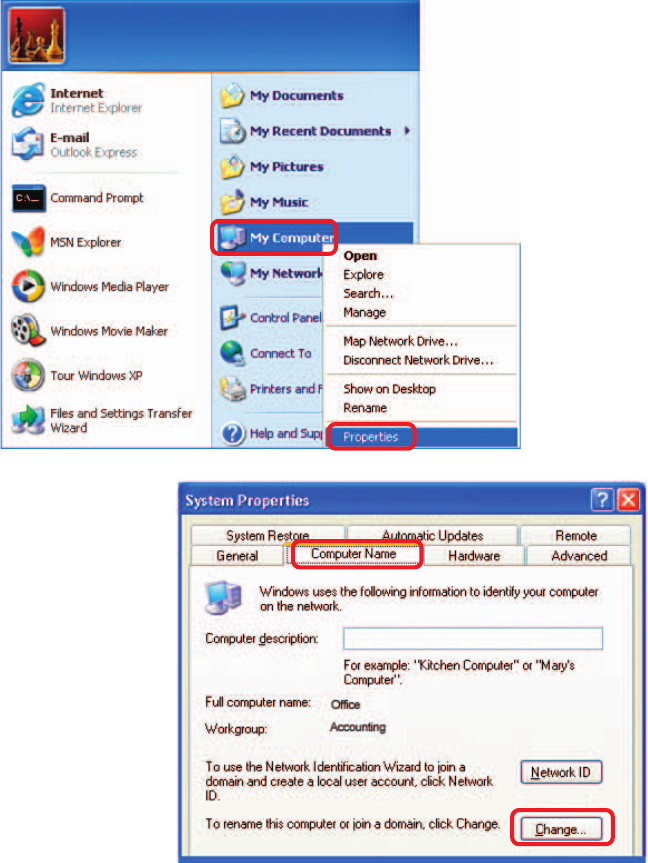
26
Networking Basics (continued)
Select the Computer
Name Tab in the System
Properties window.
You may enter a
Computer Description if
you wish; this field is
optional.
To rename the computer
and join a domain, click
Change.
Click Start (in the lower left corner of the screen).
Right-click on My Computer.
Select Properties.
To name your computer using Windows XP, please follow these directions:
Naming your Computer
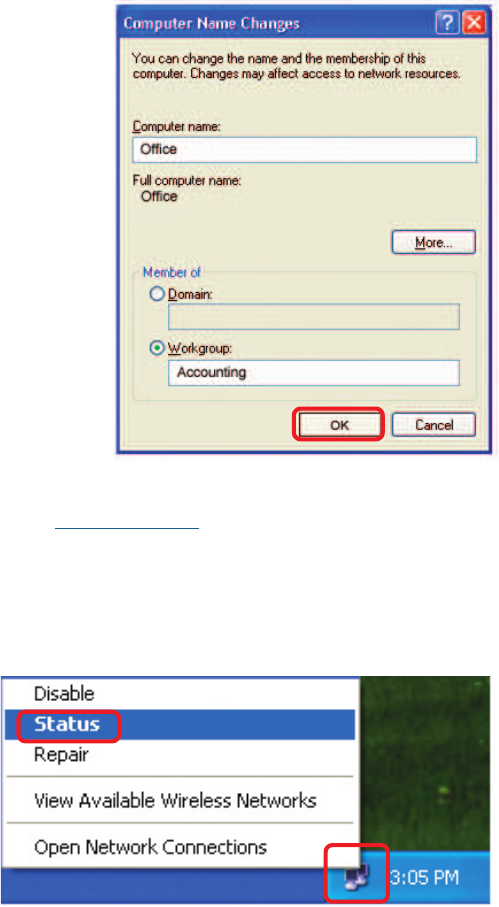
27
Networking Basics (continued)
In this window, enter the
Computer name.
Select Workgroup and enter
the name of the Workgroup.
All computers on your network
must have the same
Workgroup name.
Click OK.
Checking the IP Address in Windows XP
The adapter-equipped computers in your network must be in the same IP address range
(see Getting Started in this manual for a definition of IP address range.) To check on the
IP address of the adapter, please do the following:
Right-click on the
Local Area
Connection icon
in the task bar.
Click on Status.
Naming your Computer (continued)
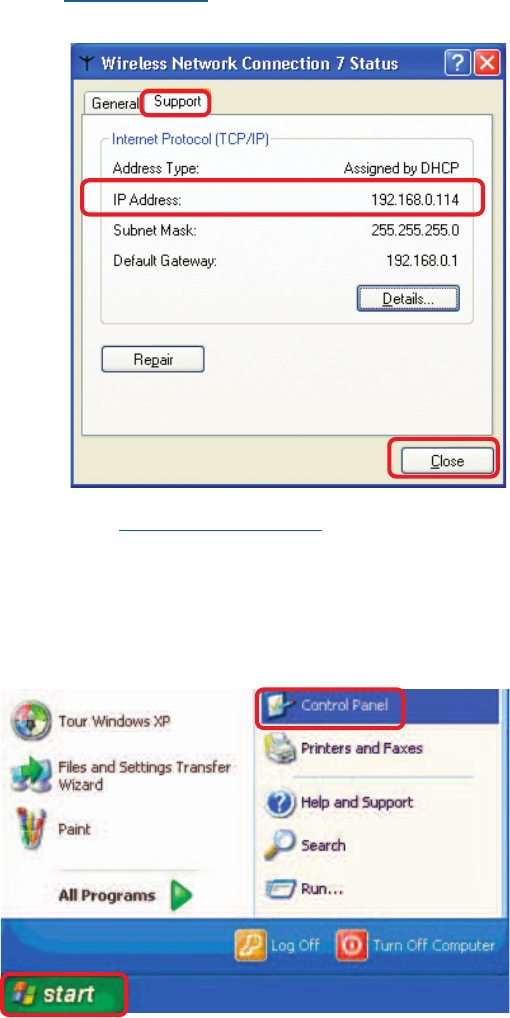
28
Networking Basics (continued)
This window will appear.
Click the
Support tab.
Click Close.
Assigning a Static IP Address in Windows XP/2000
Note: DHCP-capable routers will automatically assign IP addresses to the computers on
the network, using DHCP (Dynamic Host Configuration Protocol) technology. If you are
using a DHCP-capable router you will not need to assign static IP addresses.
If you are not using a DHCP capable router, or you need to assign a static IP address,
please follow these instructions:
Go to Start.
Double-click on
Control Panel.
Checking the IP Address in Windows XP